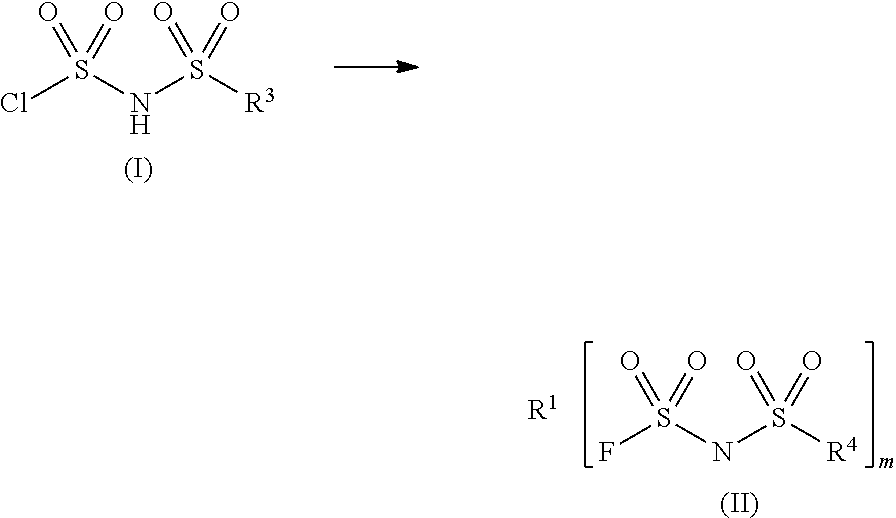Sulfonylimide salt and method for producing the same
a technology of sulfonylsulfonylsulfonyl and sulfonylsulfonylsulfonylsulfonylsulfonylsulfonylsulfonylsulfonylsulfonylsulfonylsulfonylsulfonylsulfonylsulfonylsulfon
- Summary
- Abstract
- Description
- Claims
- Application Information
AI Technical Summary
Benefits of technology
Problems solved by technology
Method used
Image
Examples
synthesis example 1
Synthesis of Chlorosulfonyl Isocyanate
[0090]In a 200 ml reaction vessel equipped with a stirrer, a thermometer, a reflux apparatus and a gas introducing tube, 80.1 g (1.0 mol) of liquid sulfuric anhydride (SO3) was charged and 61.5 g (0.53 mol) of a cyanogen chloride gas (CNCl) was introduced at a temperature of 25° C. to 35° C. over 2 hours, and the temperature of the reaction solution was adjusted to 25° C. to 30° C., followed by stirring for 0.5 hour. After completion of the reaction, the reflux apparatus and the gas introducing tube were removed from the reaction vessel, followed by distillation under a normal pressure to obtain a colorless transparent liquid: 83.7%) as a fraction at 106° C. to 107° C. (yield (amount): 118.5 g, 0.83 mol, yield (percentage).
synthesis example 2
Synthesis of Di(chlorosulfonyl)imide
[0091]In a 500 ml reaction vessel equipped with a stirrer, a thermometer, a reflux apparatus and a dropping device, 148.7 g (1.28 mol) of chlorosulfonic acid (ClSO3H) was added, followed by heating to 120° C. Then, 180.4 g (1.27 mol) of chlorosulfonyl isocyanate obtained in the same manner as in Synthesis Example 1 was added to the reaction vessel from the dropping device over 2 hours and the mixed solution was heated to 150° C., followed by stirring for 6 hours. After completion of the reaction, the reflux tube and the dropping device were removed from the reaction vessel, followed by distillation under reduced pressure to obtain a colorless transparent liquid as a fraction at 104° C. to 106° C. (0.3 kPa) (yield (amount): 178.4 g, 0.83 mol, yield (percentage): 65.6%).
[0092]Compound identification was carried out by IR (Varian 2000 FT-IR, manufactured by Varian, Inc., liquid membrane technique) and it was confirmed that the resulting colorless tra...
synthesis example 3
Synthesis of Bis[di(fluorosulfonyl)imide]zinc salt
[0093]In a 20 ml reaction vessel, 2.18 g (0.01 mol) of di(chlorosulfonyl)imide and 4.36 g of acetonitrile were added, followed by stirring. Into the reaction vessel, 2.63 g (0.025 mol) of ZnF2 (Zinc fluoride) was added, followed by conducting a reaction at room temperature (25° C.) for 24 hours. The reaction solution was filtrated and the filtered material was washed with 5 g of acetonitrile, and then the solution prepared by combining the filtrate with the wash liquid was analyzed by 19F-NMR (“Unity plus, Model 400”, manufactured by Varian, Inc., internal standard substance: trifluoromethylbenzene, integration time: 32). A peak area of the resulting chart was measured and the rate of conversion from chlorine into fluorine was determined and thus it was confirmed that the reaction quantitatively proceeded and a bis[di(fluorosulfonyl)imide]zinc salt was obtained.
[0094]19F-NMR (CD3CN): δ56.0
PUM
| Property | Measurement | Unit |
|---|---|---|
| temperature | aaaaa | aaaaa |
| reaction time | aaaaa | aaaaa |
| reaction time | aaaaa | aaaaa |
Abstract
Description
Claims
Application Information
 Login to View More
Login to View More - R&D
- Intellectual Property
- Life Sciences
- Materials
- Tech Scout
- Unparalleled Data Quality
- Higher Quality Content
- 60% Fewer Hallucinations
Browse by: Latest US Patents, China's latest patents, Technical Efficacy Thesaurus, Application Domain, Technology Topic, Popular Technical Reports.
© 2025 PatSnap. All rights reserved.Legal|Privacy policy|Modern Slavery Act Transparency Statement|Sitemap|About US| Contact US: help@patsnap.com



